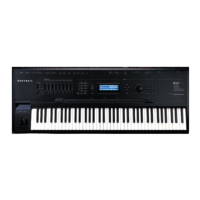3-10
Setup Mode
The ARPEGGIATOR & ARPEGGIATOR 2 (ARP1, ARP2) Pages
FloatResaddsabitofapparentrandomnesstotheprocess.“Float”meansthatwhenthe
Arpeggiatorreachestheshiftlimit,itresets—butnottoitsoriginalpitchaswithplainReset.
LikeUnipolarandBipolar,itlooksatthefirstnotethatwouldexceedtheshiftlimit,and
calculatesthe
intervalbetweenthatnoteandtheshiftlimit.Itthenrestartsthecycleoflatched
notes,transposingtheentirecyclebytheintervalitjustcalculated,thenshiftingeach
subsequentcyclebythevalueofNoteShift,unt ilitreachestheshiftlimitagain.
Here’saverysimpleexample.Supposethat
theonlynoteintheArpeggiatorcycleis C4,Note
Shiftis 4(athird),andShiftLimitis 7(sonoteswon’tgetshiftedaboveG4).TheArpeggiator
playsC4,thenE4.ThenextnoteshouldbeG
#
4,butthat’sabovetheshiftlimit—sothePC3
calculatesthedifferencebetweenthatG
#
4andtheshiftlimit(G4):onesemitone.Itaddsthat
differencetotheoriginalstartingnote(C4)andplaysthatnotenext—C
#
4.Thenextnote(F4)is
withintheshiftlimit,butthenextnote(A4)isn’t,soitgetstranslatedintoD4—andsoon.
FloatUniusesthesameconceptandappliesittoUnipolarmode:whentheArpeggiatorreaches
theshiftlimit,itcalculatesthedifferencebetweenthenextnote
andthelimit,andtransposesthe
nextcycleofnotesdownbythatinterval,thenshiftseachsubsequentcycledownuntilitreaches
theoriginalpitch.FloatBipissimilartoFloatUni,butthedownwardshiftlimitisn’tthe
originalpitch,it’sthenegativeoftheShiftLimitvalue.
The
Arpeggiatorcanbealotoffun,evenifyoudon’talwaysunderstandexactlywhatit’sdoing.
Keepinmindthatthestrangerthealgorithmyousetup,themoreunlikelythenoteswillstay
closetoonekey,soifyouwanttocreatesomethingthat’sgoingtosound
atalldiatonic,keepit
simple.
Shift Pattern (ShiftPatt)
ShiftPattengagesastepsequencerforarpeggiatornotepatterns.Theinputtednotenumberof
eachplayedkeyisshiftedaccordingtoasequencedpattern,thus“ShiftPattern.”Thereare69
preprogramedshiftpatternsincludingmanyusefulchords,intervals,andrhythms.Each
patterncanhave
upto48steps,andeachstepcanshiftnotesby±127half‐stepsorplaynothing.
StepsareplayedbackattheratesetforBeatsontheARPEGGIATORpage.Keepinmindthat
ShiftPatternsareeffectedbyeveryparameterontheARPEGGIATORpage,whichcanbe
the
causeofunexpectedvariation,orawaytoaddinterestingvariationtoapattern.
ShiftPatternsaremosteasilyusedandunderstoodwhentriggeredbyonlyonekey atatime.
OnewaytopreventtriggeringfrommultiplekeysistouseoneoftheLatchtypes1NoteAuto,
1NoteAutoLow,or
1NoteAutoHiwhenusingashiftpattern(seeLatch on page 3‐12,below.)
Triggeringshiftpatternsfromonekeyallowsthepreprogramedpatternstosoundlikewhat
youwouldexpectfromtheirnames.Ifnootherkeysareplaying,patternswillstartovereach
timeakeyispressed(therearesome
exceptionstothiswhenusingARPEGGIATORLatchparameters
otherthan“Keys,”thoughanewlytriggeredpatternwillalwaysstartatstep1.)WhentriggeringShift
Patternsfrommorethanonekeyatatime,eachconsecutivestepofthepatternshiftsthenote
fromadifferentinputtedkey,theorderof
whichisdecidedbytheorderparameteronthe
ARPEGGIATORpage.Thismeansthateachkeywillnotbeshiftedbyeverystepofthepattern,
causingyoutoonlyhearpartofthepatternfromeachkey,oftenmakingthepattern
unrecognizable.ThoughtriggeringaShiftpatternfrommultiple
keyscanbeusedcreatively,it
canalsomakeithardtopredictwhattheoutputwillbe.
Youcanedittheincludedpatternsbypressing“Edit”withapatternhighlightedintheShiftPatt
field(seeeditscreenbelow.)Thetoplineofthe“EditShiftPatt”pageshowsthefullname
fora
patternwhosenamedoesnotfitontheARPEGGIATORpage.Thispagealsodisplaysthe
pattern’stotalnumberofsteps,aswellaspatterndirection.PressingStep‐removesthelaststep
inthelist,pressingStep+insertsanewnotestepattheendofthelist(the
patterneditor
remembersthevaluesofremovedstepsuntilyousaveorexit.)Usethecursortomovebetween
patternsteps,usethealphawheel,alphanumericpad,orplus/minusbuttonstoenterthenote
shiftamountforeachstep.PressMoretoseeasecondpageforpatternswithmorethan
24steps.
Youcaninsertastepwithavalueof“none”byentering‐127 andthenshiftingdownonemore

